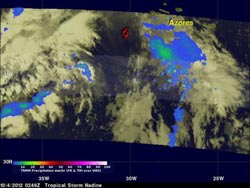NASA notes Nadine now no more

TRMM data on Oct. 3 at 10:49 p.m. EDT showed that Nadine was producing light to moderate rainfall (blue/green) in an area well east of the center of circulation, while the center (red symbol) was rain-free. The approaching cold front that would help bring about Nadine's demise was generating rainfall west of Nadine's center.<br><br>Credit: SSAI/NASA, Hal Pierce<br>
NASA's Tropical Rainfall Measuring Mission (TRMM) satellite passed above long-lasting Nadine for the last time before the tropical storm's dissipation on October 4, 2012 at 0249 UTC (10:49 p.m. EDT October 3, 2012).
TRMM measures rainfall from space and there was very little remaining in Nadine when it passed overhead. Rainfall data from TRMM's Microwave Imager (TMI) and Precipitation Radar (PR) showed that Nadine was producing light to moderate rainfall in an area well east of the center of circulation, while the center was rain-free.
TRMM data showed that the approaching cold front that would help bring about Nadine's demise was generating rainfall west of Nadine's center.
According to NOAA Hurricane Ginger lasted 28 days in the Atlantic Ocean in 1971. In the Pacific Ocean Hurricane John, renamed Typhoon John when it crossed the International Dateline holds the record with a 31 day lifetime during August and September 1994.
Although not the longest-lived tropical cyclone, Nadine is in the top 50 longest-lasting tropical cyclones in either ocean basin.
Media Contact
More Information:
http://www.nasa.govAll latest news from the category: Earth Sciences
Earth Sciences (also referred to as Geosciences), which deals with basic issues surrounding our planet, plays a vital role in the area of energy and raw materials supply.
Earth Sciences comprises subjects such as geology, geography, geological informatics, paleontology, mineralogy, petrography, crystallography, geophysics, geodesy, glaciology, cartography, photogrammetry, meteorology and seismology, early-warning systems, earthquake research and polar research.
Newest articles

High-energy-density aqueous battery based on halogen multi-electron transfer
Traditional non-aqueous lithium-ion batteries have a high energy density, but their safety is compromised due to the flammable organic electrolytes they utilize. Aqueous batteries use water as the solvent for…

First-ever combined heart pump and pig kidney transplant
…gives new hope to patient with terminal illness. Surgeons at NYU Langone Health performed the first-ever combined mechanical heart pump and gene-edited pig kidney transplant surgery in a 54-year-old woman…

Biophysics: Testing how well biomarkers work
LMU researchers have developed a method to determine how reliably target proteins can be labeled using super-resolution fluorescence microscopy. Modern microscopy techniques make it possible to examine the inner workings…





















